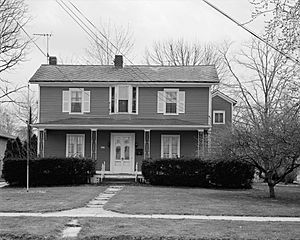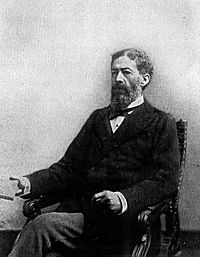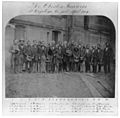John Mercer Langston facts for kids
Quick facts for kids
John Mercer Langston
|
|
|---|---|
 |
|
| Member of the U.S. House of Representatives from Virginia's 4th district |
|
| In office September 23, 1890 – March 3, 1891 |
|
| Preceded by | Edward Carrington Venable |
| Succeeded by | James F. Epes |
| United States Minister Resident to the Dominican Republic Acting |
|
| In office March 26, 1884 – June 23, 1885 |
|
| President | Chester A. Arthur Grover Cleveland |
| Preceded by | Position established |
| Succeeded by | John Thompson |
| United States Minister Resident to Haiti | |
| In office November 27, 1877 – June 30, 1885 |
|
| President | Rutherford B. Hayes James A. Garfield Chester A. Arthur Grover Cleveland |
| Preceded by | Ebenezer Bassett |
| Succeeded by | George Washington Williams |
| Personal details | |
| Born |
John Mercer Langston
December 14, 1829 Louisa, Virginia, U.S. |
| Died | November 15, 1897 (aged 67) Washington, D.C., U.S. |
| Political party | Republican |
| Spouse | Caroline Wall |
| Children | 5 |
| Education | Oberlin College (BA, MA) |
| Signature | |
John Mercer Langston (December 14, 1829 – November 15, 1897) was an important American leader. He was an abolitionist who fought to end slavery, a lawyer, an educator, and a politician. He helped start the law school at Howard University and was the first president of what is now Virginia State University, a college for Black students.
Langston made history as the first Black person elected to the U.S. Congress from Virginia. He was born free in Virginia to a Black mother and a white father. His life's work was dedicated to freedom, education, and equal rights for African Americans. He was also the great-uncle of the famous poet Langston Hughes.
Contents
Early Life and Learning
John Mercer Langston was born free in 1829 in Louisa County, Virginia. His mother, Lucy Jane Langston, was a freedwoman of mixed African-American and Native American heritage. His father, Ralph Quarles, was a white planter from England who had freed Lucy and their daughter years before. John and his two older brothers, Gideon and Charles Henry, were born free because their mother was free.
When John was four, both his parents died. His father had arranged for a Quaker friend, William Gooch, to care for his children and set aside money for their education. Gooch moved with the boys to Chillicothe, Ohio, a free state. John later attended the private Gilmore High School.
John followed his brothers to Oberlin College, where he earned a bachelor's degree in 1849 and a master's degree in theology in 1852. He wanted to study law, but many law schools would not accept him because he was Black. So, he "read the law" (studied as an apprentice) under an abolitionist lawyer named Philemon Bliss. In 1854, John Langston became the first Black person admitted to the Ohio bar, which meant he could practice law.
Family Life and Connections
In 1854, Langston married Caroline Matilda Wall, who was also a student at Oberlin College. Caroline was from North Carolina, the daughter of an enslaved mother and a wealthy white planter. Her father had freed her and her sister and sent them to Ohio to be educated in a Quaker home. Caroline was very smart and supported Langston's work. They had five children together.
Their daughter, Nettie, also graduated from Oberlin College. She married James Carroll Napier, who had been a student at Howard University's law school, where Langston was the dean. Nettie later became an important activist. James Carroll Napier became a successful lawyer and businessman in Nashville, Tennessee. He was even appointed to a high position in President William Howard Taft's government.
Fighting for Rights and Freedom
John Langston and his brothers, Gideon and Charles, were very active in the abolitionist movement. They helped enslaved people escape to freedom in the North using the Underground Railroad in Ohio. In 1858, John and Charles led the Ohio Anti-Slavery Society. John also played a big part in the famous Oberlin–Wellington Rescue of 1858, where people helped a runaway slave escape from slave catchers.
When the government allowed Black soldiers to join the Union Army in 1863, John Langston helped recruit hundreds of African American men. He believed that if Black men fought for their country, they should have the right to vote and be treated equally.
After the American Civil War, Langston worked for the Freedmen's Bureau. This was a government organization that helped newly freed slaves. It helped them find jobs, set up schools, and even ran a bank.
In 1864, Langston became president of the National Equal Rights League. This group worked to end slavery, promote unity among Black people, and ensure equal rights under the law. Langston traveled widely to build support for the League across the country.
A Leader in Education and Government
In 1868, Langston moved to Washington, D.C., to start the law school at Howard University. This was the first law school for Black students in the United States. He became the founding dean and worked hard to make it a strong school with high academic standards.
Langston also helped Republican Senator Charles Sumner write the Civil Rights Act of 1875. This important law aimed to guarantee equal treatment for all citizens in public places.
In 1877, President Rutherford B. Hayes appointed Langston as the U.S. Minister to Haiti and also to the Dominican Republic. This was a diplomatic role, meaning he represented the United States in these countries.
After his time as a diplomat, Langston returned to Virginia in 1885. He became the first president of the Virginia Normal and Collegiate Institute in Petersburg, Virginia. This college was founded as a historically black college (HBCU).
Serving in Congress
In 1888, Langston decided to run for a seat in the U.S. House of Representatives. He ran as a Republican. He lost the election at first, but he challenged the results because there were problems with voter intimidation and fraud. After 18 months, a committee in Congress agreed that Langston had won, and he took his seat.
He served for the last six months of the term. Even though he lost his bid for reelection, Langston made history as the first Black person elected to Congress from Virginia. He was one of only five African Americans elected to Congress from the South during the late 1800s, a time when new laws, called Jim Crow laws, were being passed to stop Black people from voting. After this period, no African Americans would be elected from the South until 1972, after the Voting Rights Act of 1965 was passed to protect voting rights.
From 1891 until his death in 1897, Langston practiced law in Washington, D.C.. He passed away at his home on November 15, 1897.
Lasting Impact and Honors

John Mercer Langston's legacy lives on through many honors:
- His home in Oberlin, Ohio, the John Mercer Langston House, is a National Historic Landmark.
- The town of Langston, Oklahoma, founded in 1890 as an all-Black town, was named after him.
- Langston University, a historically black college in Oklahoma, was renamed in his honor in 1941.
- Several schools were named after him, including Langston High School in Johnson City, Tennessee, John M. Langston High School in Danville, Virginia, and Langston High School in Hot Springs, Arkansas.
- John Mercer Langston Elementary School in Washington, D.C., was also named for him.
- In 2021, a part of U.S. Route 29 in Virginia in Arlington County, Virginia was renamed Langston Boulevard in his honor.
- Langston Golf Course in Washington, D.C. is also named after him.
Images for kids







